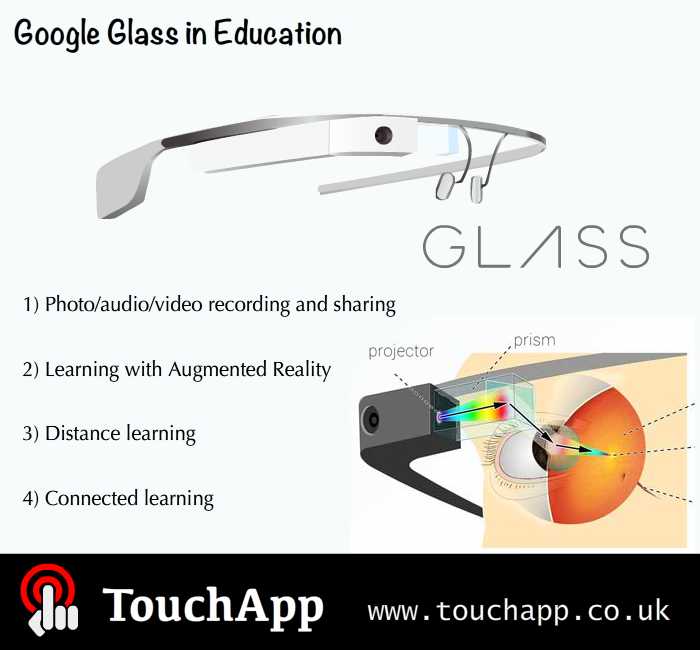Google Glass is Google’s attempt to leap mankind into the future by supplying wearable technology that is easily accessible by its users. Poised as a lightweight and nonintrusive eyewear, Google Glass responses to voice commands and taking photo/audio/video with a wink. Google Glass gives its wearers ultimate access to digital information and the most modern communication abilities. It also presents teachers and students of the 21st century endless possibilities, which are only restricted by users’ own imaginations.
Google Glass can potentially enhance the education experience through the following perspectives:
1. Photo/audio/video recording and sharing
For educational means, the video capturing ability of Google Glass allows students to record exactly what they see and hear as well as recording his or her comments in real-time. Students not only can record their lectures for future reference, but it is easy to share them with others. Using the recoding function of Google Glass, it is effortless for teachers and students to collect visual resources to create more vivid projects and presentations. Teachers can also see almost firsthand how their tutorial sessions are seen and received through the eyes of their students so they can improve their teaching techniques accordingly.
2. Learning with Augmented Reality
Using augmented reality (AR) technology, Google Glass provides layers of related digital information on top of the physical world in front of wearers’ eyes. Students and teachers can now easily take their educations into the field with them transmitting, sharing and saving data while having complete on-hand access to research caches, instruction materials and advice from innumerable sources. For example, medical students can check the anatomy of the human body with Google Glass while dissecting a cadaver or conducting a preliminary patient assessment. All these inputs add new dimensions to the learning experience and loads of extra knowledge gained from a single project or activity.
Google Glass can enormously facilitate distance learning by various means. Remote tutoring can be streamed directly on the Glass and it is easy to be accessed anytime, anywhere than laptops or smartphones. Tutors can mimic the classroom experience and provide real-time demonstration and hands-on experience for remote or home-schooled students. Teachers can also feedback, adjust their lesson plan or send reminder notes to students promptly. For instance, artist student could be sculpting a statue or painting a portrait while getting advice from live experts analyze the view picked up by the Google Glasses. Google Glass will also enhance accessibility for students with visual, auditory and physical disabilities.
4. Connected learning
Google Glass allows learners and educators to stay connected to an interactive digital environment and the entire Internet all the time. Learning collaboration involving different groups of students/teachers learning/working together over the Internet is made easier with Google Glass. Google also provides various online tools to break the tradition barriers between culture and location diversities to smooth global education. For example, Google Glass coupled with Google Translator facilitates communication between users speaking different languages from all over the world.
Concerns of using Google Glass:
Despite it’s obvious benefits, not everyone embraces Google Glasses in the educational system. Invasion of privacy is the major concerns of many teachers and parents. There are bars and restaurants already banning the use of Google Glasses. Only a very small number of schools/universities have tried Google Glasses at small scale to experiment with this device. Google has a great responsibility to invest in research and education to guide people to use this disruptive new technology appropriately.
Follow us on Twitter: @TouchApp_uk
From Mobile App development company TouchApp
![]()
